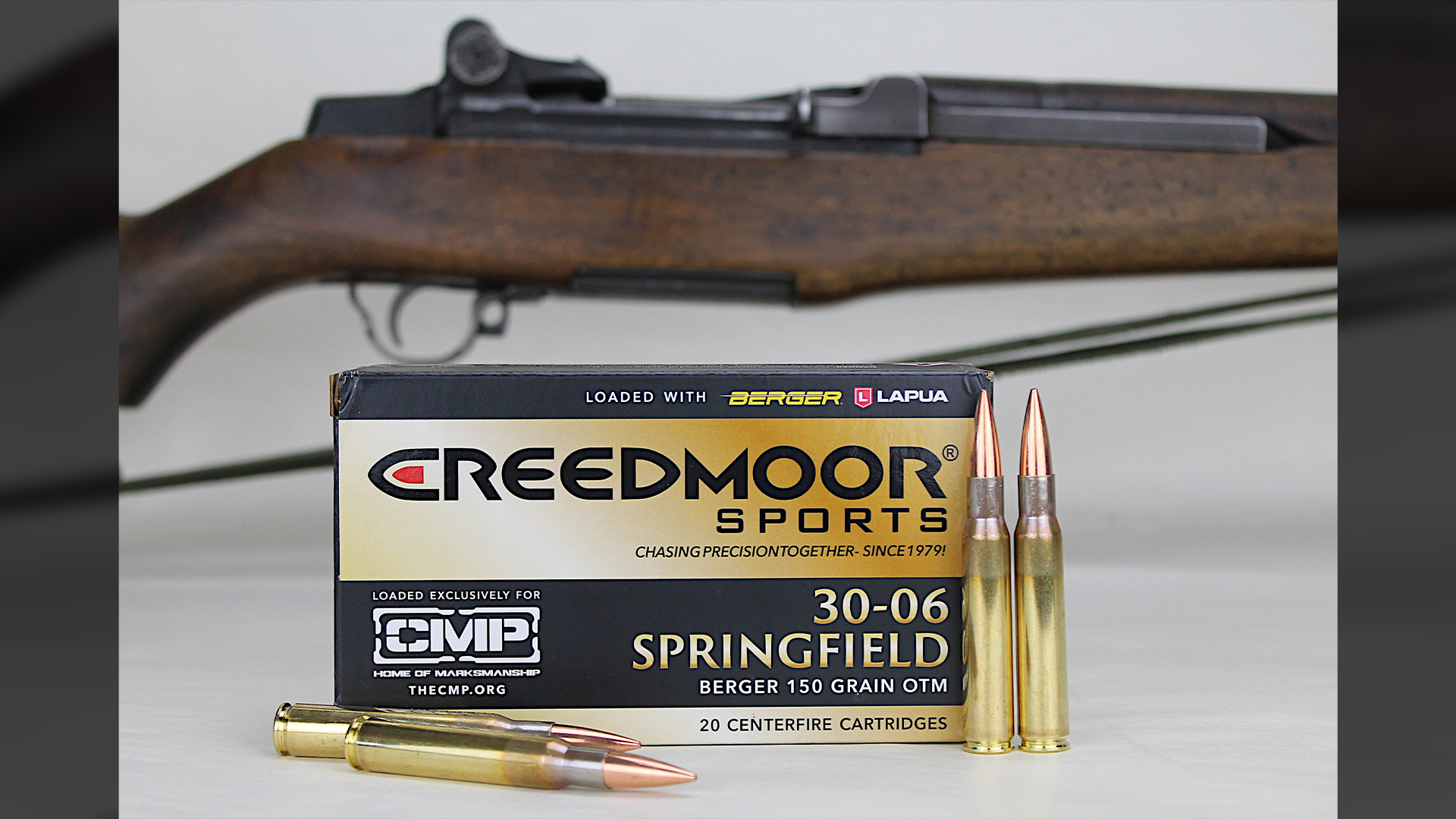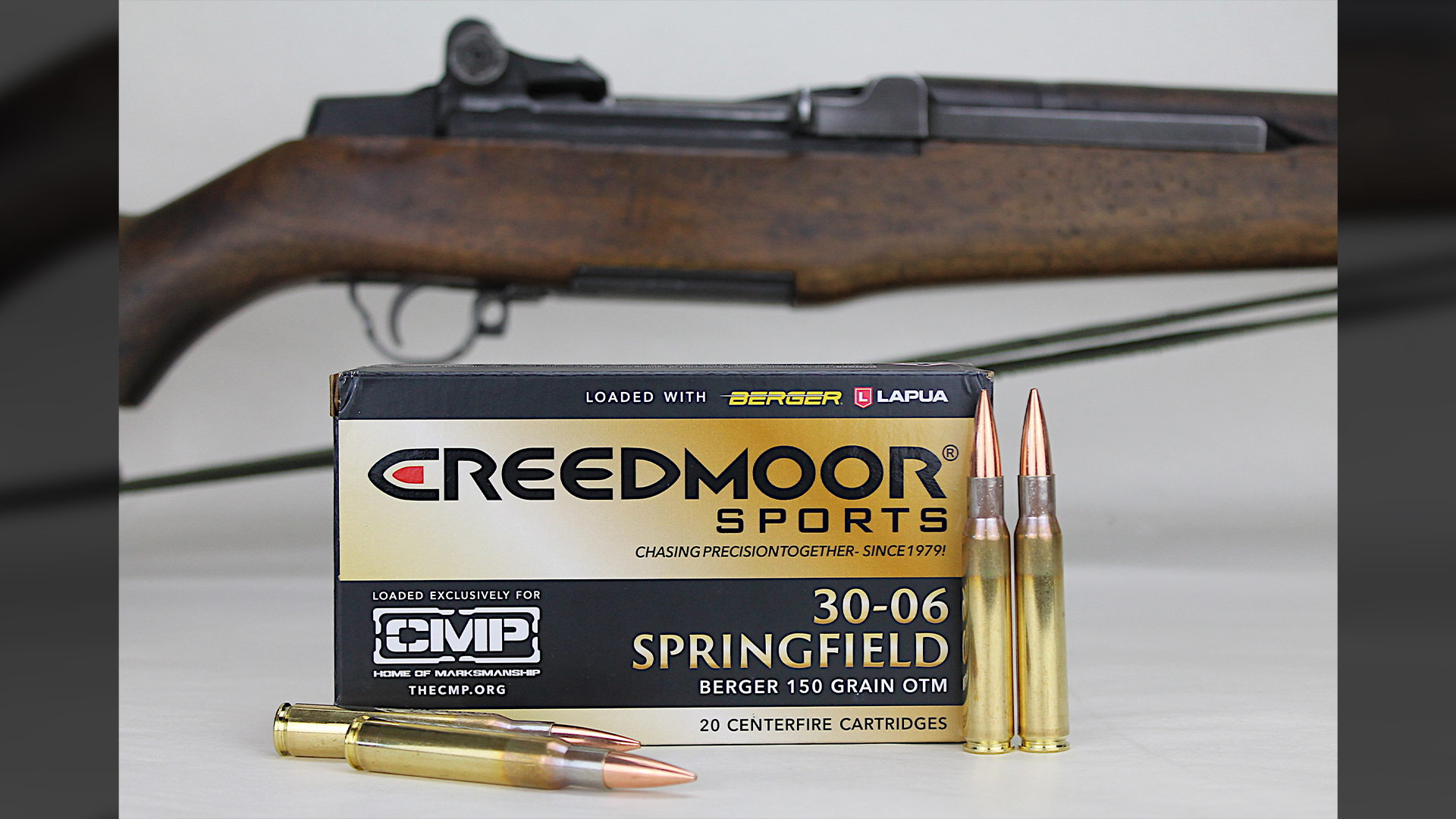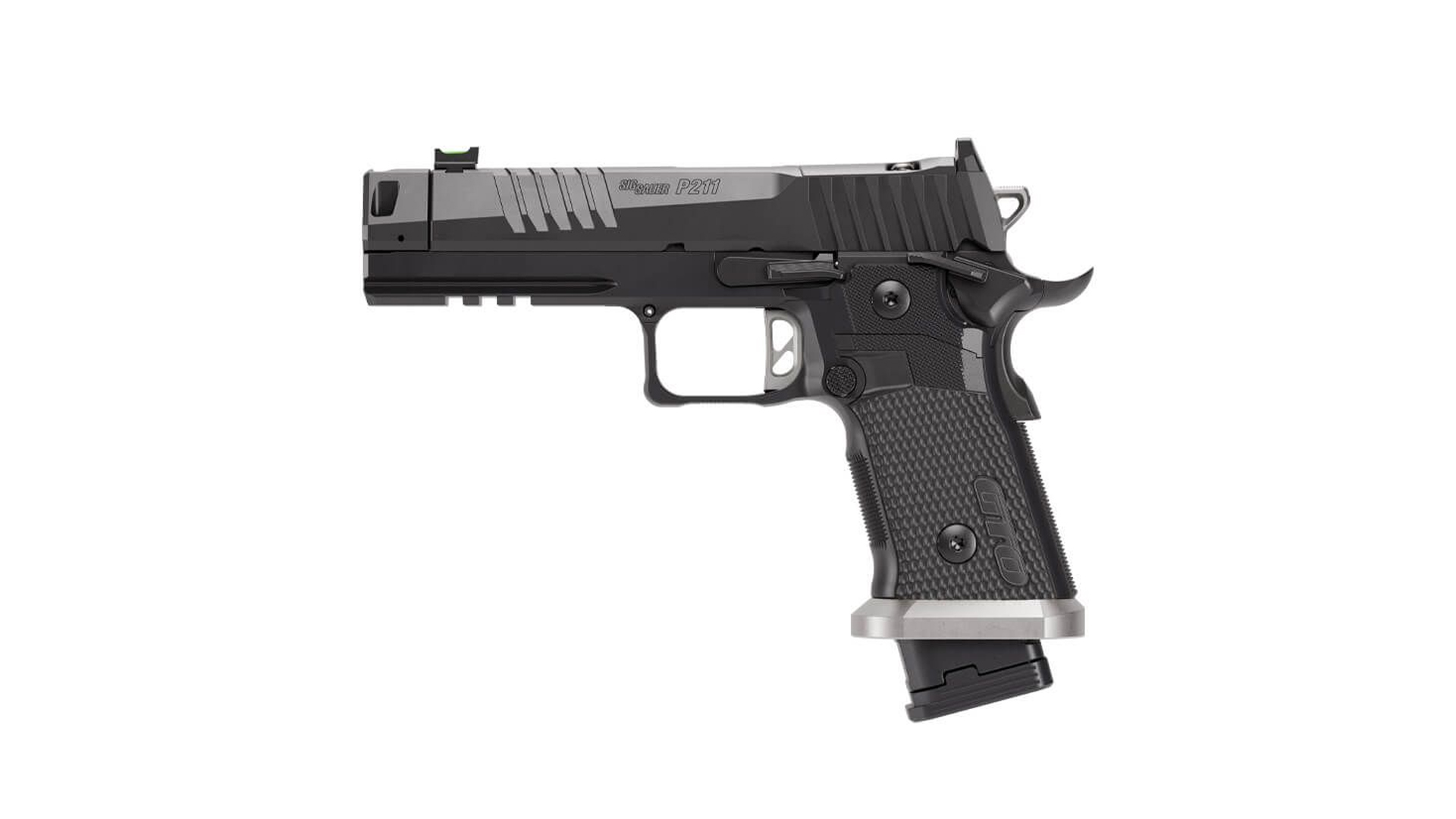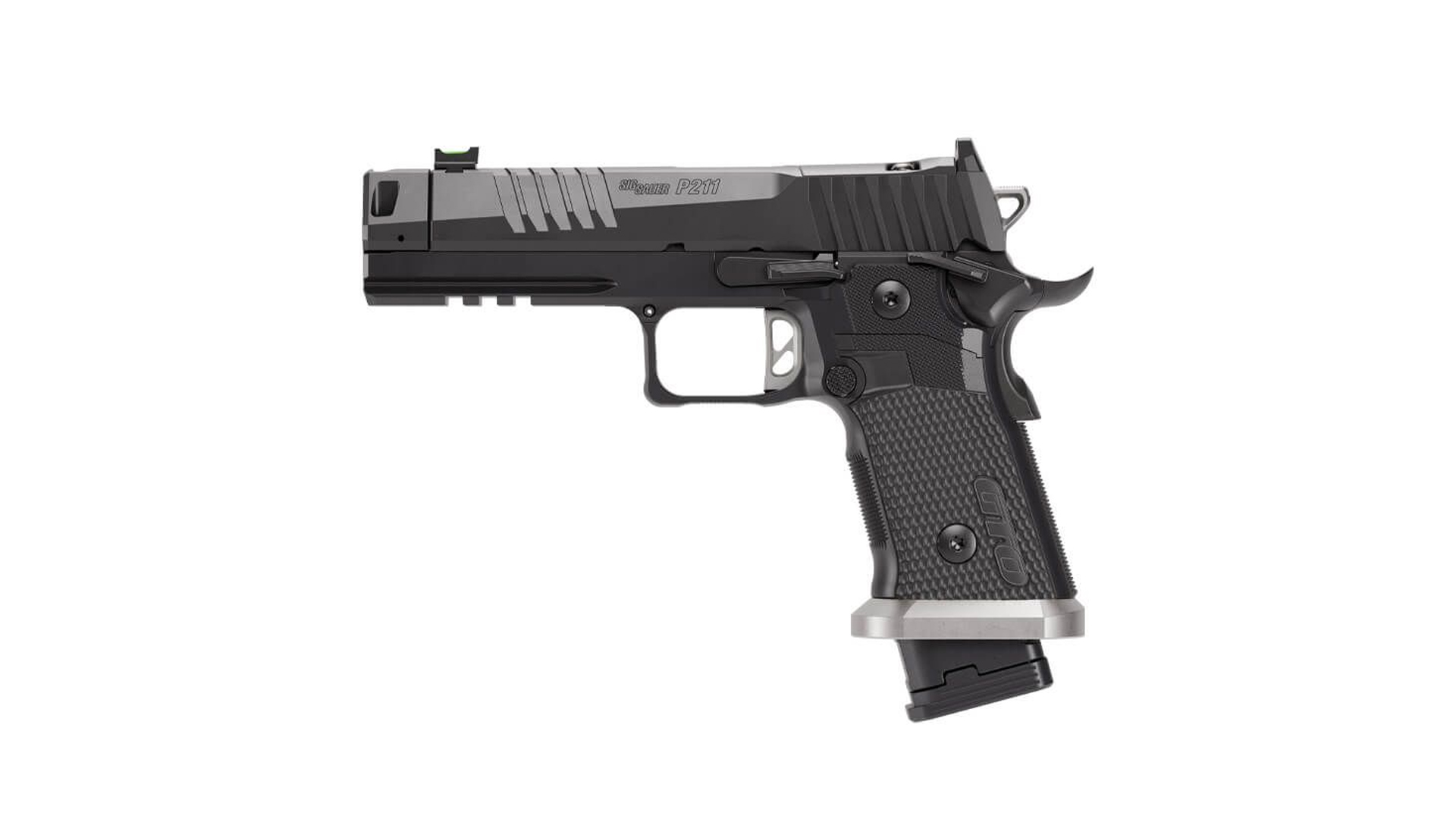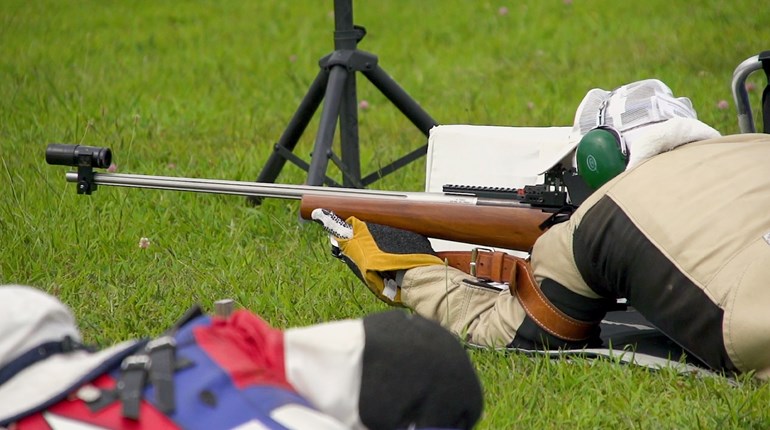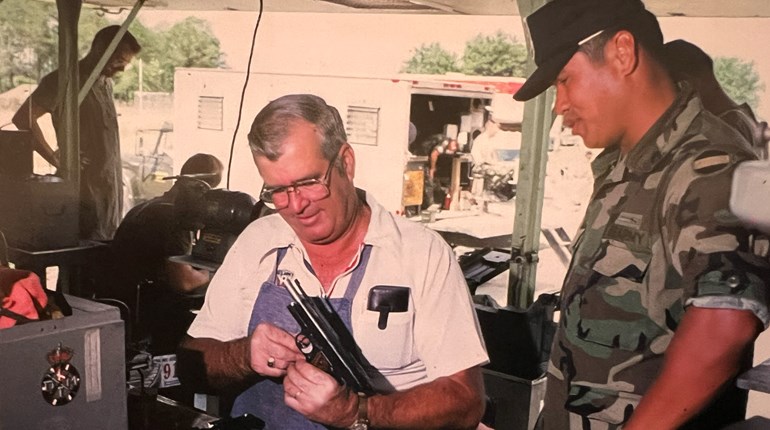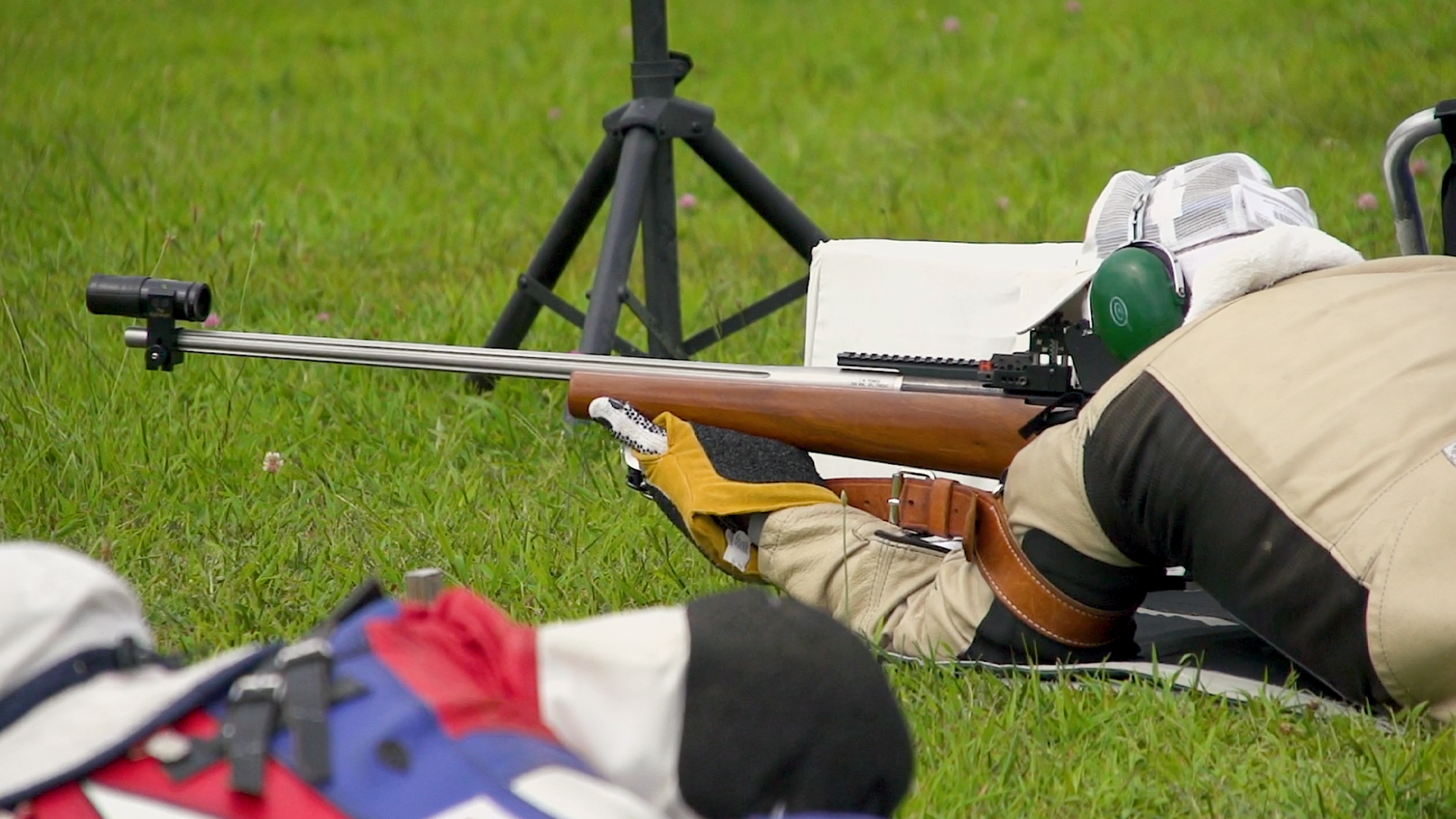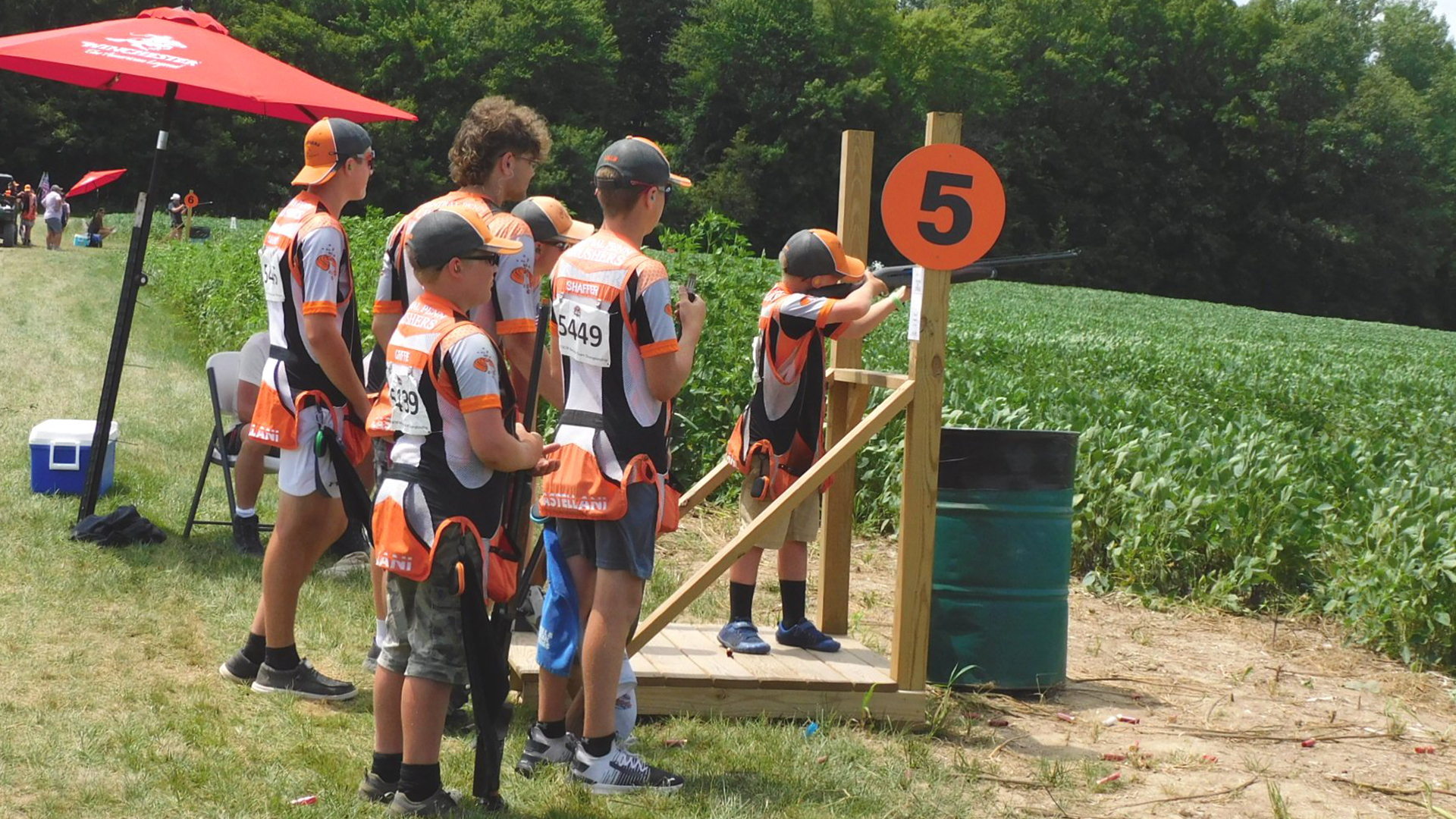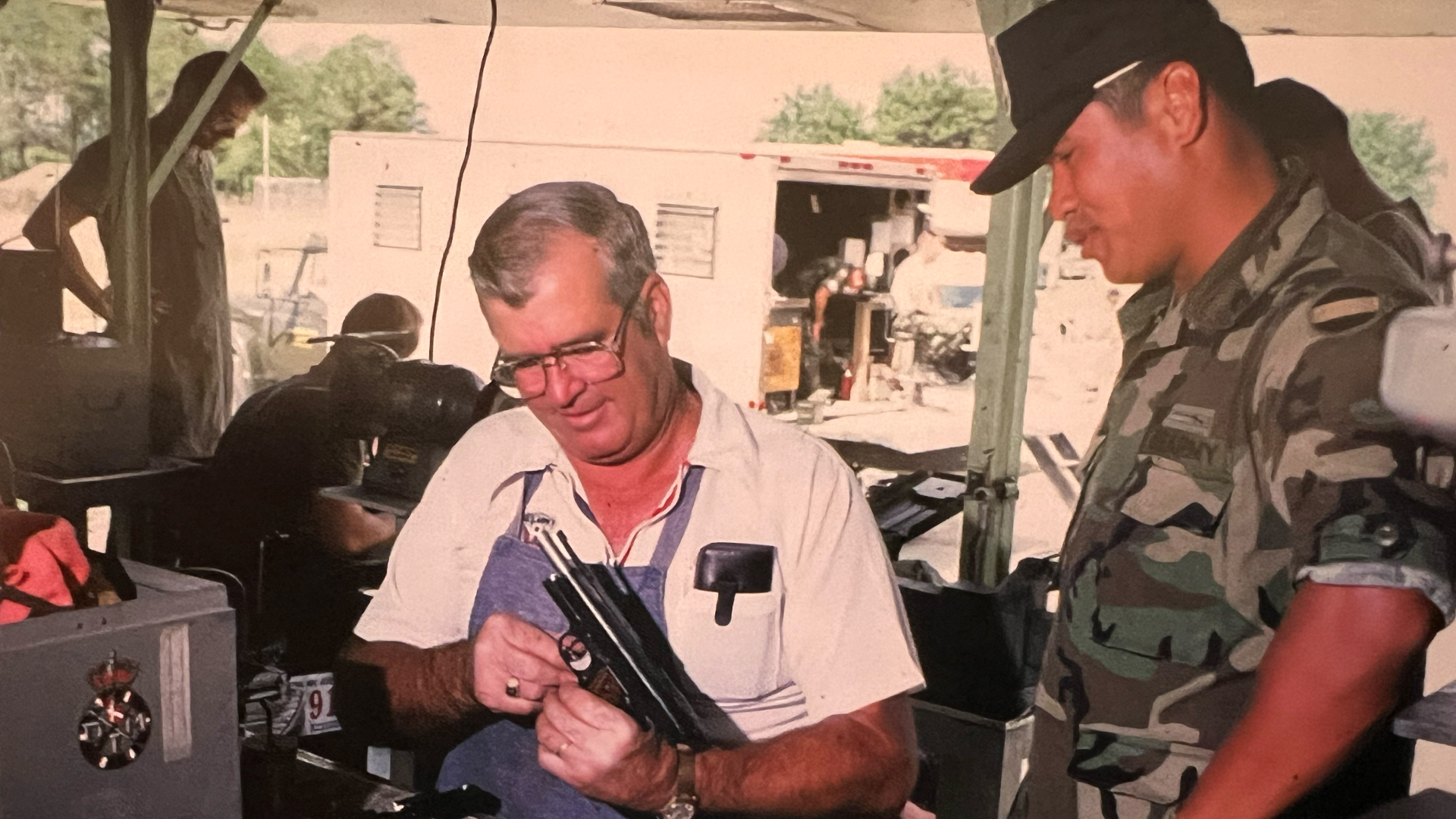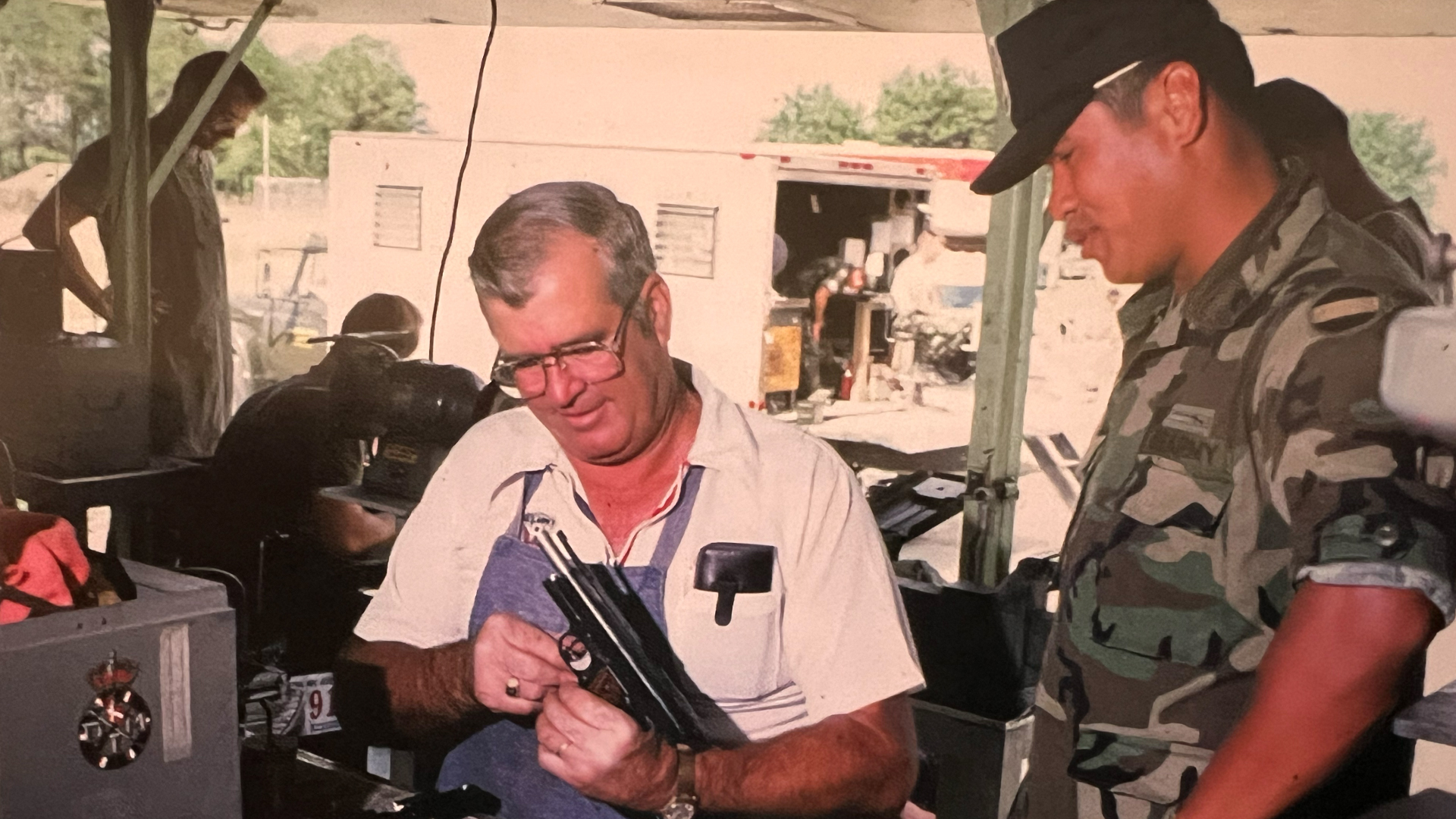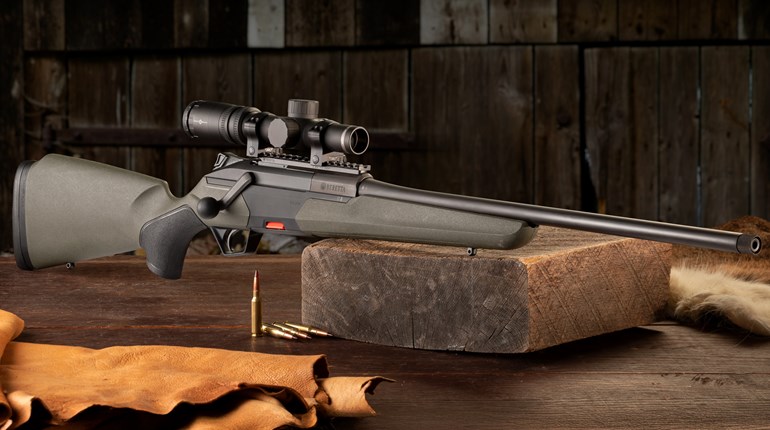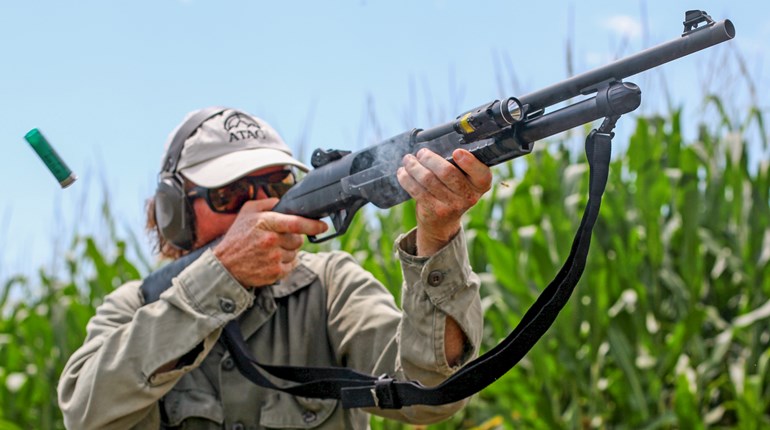
Above: Iowa shooter Chris Westergaard at the 1935 Smallbore Championships at Camp Perry. His equipment—Ballard rifle with palm rest, Fecker scope, cloth shooting coat and street trousers—is minimal by the standards of modern smallbore position shooters.
If you haven’t already, be sure to read Part 1 and Part 2 of this series celebrating the National Smallbore Outdoor Rifle Championship Centenary.
The country was starting to feel the pinch of the 1929 economic collapse, but shooters flocked to Camp Perry in 1930 anyways. Vere Hamer, a lanky 26-year-old Minnesotan, doped the wind better than anyone else in the 20-shot, 200-yard Smallbore Wimbledon Match and won. It was just one of the four matches that made up the aggregate for the National Smallbore Championship but, more importantly, it was the longest stage. Hamer’s victory tied him on score with the 1929 champion Eric Johnson and secured the national title on the tie-breaking rule.

1931
The National Matches were shaved by the budget ax in 1931, meaning a reduced staff. The individual smallbore championship turned out to be a battle between two New Englanders. Connecticut’s Fred Kuhn bested Harold Allyn of Massachusetts by one point. In the Dewar Match, Kuhn made the first of nine appearances on the roster, where the U.S. bested Britain.
1932
The Depression was in full swing by 1932. Federal funding for the National Matches was eliminated. The NRA picked up the ball―supporting regional high power matches while smallbore managed to hold all its events at Camp Perry.
That same year however, smallbore attendance dipped―but among those who were able to scrimp and save enough for the trip were some of the best bellyshooters in the nation. In the Dewar, be-speckled Brad Wiles and J.D. Wade boasted perfect scores at 50 yards. Bill Schweitzer cleaned his target at 100 yards, helping extend the U.S. Dewar winning streak.
Wiles managed a six point victory over New Jersey native William Schweitzer for the 1932 National Championship. Wiles was a Chicago native and scion of the manufacturers of the shooters’ favorite lubricant and metal preservative called “RIG”―Rust Inhibiting Grease.
1933
The October 1933 American Rifleman reported that there “was just a touch of loneliness” at Camp Perry. Now four years deep into the Depression, the Federal financial cupboard was bare leaving no money for the National Matches. Smallbore matches were less expensive, and in the face of daunting odds, the NRA nevertheless sponsored the first exclusively smallbore National Championship.

The shooting program was identical to ones from earlier years―but was squadded. There could be no grousing from the competitors that conditions favored one relay or another. Therkild “Turk” Samsoe won the national smallbore title while nipping perennial threat Thurman Randle.
The last day of the matches began with excellent conditions and all twenty Dewar shooters took the line at the same and broke the 7900 barrier for the first time. When it was reported the British had scored 7829, the U.S. Dewar Team rejoiced as it held onto the giant silver loving cup.
Ten Dewar shooters refilled their loading blocks to compete for a new challenge trophy named for its donor, the Rheinische-Westfalischen-Sprengstoff Aktiengesellschaft, a German arms corporation. The inaugural 40-shot, 50-meter prone postal match was between Germany, Great Britain and the U.S., who won the match.
To recognize exceptional performance the Camp Perry “400 Club” was formed. Membership only required that one shoot a 400 with metallic sights over the Dewar course at Camp Perry. Inducted in the inaugural class were John Adams, Virgil Z. Canfield, M. Coleman, Russell Gardner, A.E. Hart, Thomas J. Imier, Fred Kuhn, Thurman Randle, Virgil Richard, James Wade and Lawrence Wilkens.
The 1933 matches proved Ned Crossman right. Out from under the shadow of the centerfire matches the smallbore community proved that it could sustain a national event that was both independent and exciting.
1934
Competitors attending the 1934 National Smallbore Matches found Camp Perry touched up with a coat of fresh paint and new tents. Likewise, the matches underwent renovation. The championship was extended to five matches and sighters were allowed for the first time. The National Championship would be decided by a newly introduced match, 40 shots at 50 meters. The course of fire was familiar but the international targets not. With a larger aiming black, different apertures were required as well as harder holding to deal with the smaller 10-ring.

E.L. Lord finished on top in the aggregate. Lord, by virtue of this victory, became the first person awarded the Critchfield Trophy. Presented by Ohio riflemen to the NRA in honor of Brigadier General Ammon B. Critchfield, the Critchfield Trophy bears a bas-relief likeness of the revered Father of Camp Perry. In the background are 50-, 100- and 200-yard targets, and the NRA Eagle and monogram is in the lower right hand corner. A map of Ohio showing the location of Camp Perry fills the lower left. The trophy was designed by Washington D.C. artist and past NRA president, Fred M. Hakenjos. The Critchfield has always been presented to the National Smallbore Conventional Rifle Prone Champion.
Position shooting appeared with the Harry M. Pope Appreciation Match, named in honor of the famous barrel maker and practitioner of the arcane art of Schützen shooting. The match was three 20 stages in prone, kneeling and standing on the 50 meter target. Frank T. Parsons, Jr., came from Washington, D.C., to shoot only this match―which he won. Twenty-five years later the Parsons family would donate the Frank Parsons Memorial Trophy, an elaborate sterling silver chased bowl, to be presented annually to the National Conventional Smallbore Rifle Position champion.

The U.S. fielded winning teams in the Dewar, RWS, FIDAC, and Railwaymen’s matches. The RWS Match was a resounding success as the U.S. established a record and Sam Bond shot a 400―the first perfect score registered on the international target. Mrs. E. A. Holcomb became the first woman to earn a spot on the Railwaymen’s team shooting a 398, three points ahead of her husband.
Dewar Match officials, shooters, and coaches were up before the sun to shoot in the early morning’s still air. Within an hour they posted a record score. Sam Bond rang up a 400 in the Dewar, making him the first shooter from the U.S. to accomplish the feat. Bill Woodring had two close shots on his last 100-yard target that would be decided by the British scorer.
Reduced costs was a powerful incentive for many to shoot more smallbore during the lean years of the Great Depression. As a result, the sport grew to the point that it was the main stay of the NRA during the mid to late 1930s. Success in the international arena raised the consciousness of the shooting community to the potential of the discipline. Smallbore had become a serious competitive activity.
1935
Camp Perry in 1935 had a full program of service rife, pistol and smallbore. The 1933 National Champion “Turk” Samsoe regained the title after missing out in 1934.

As usual, the international matches were the focus. The selection for the Dewar Team began with the Preliminary Dewar Match. The quality of the shooting was so high during the tryouts that the average score for a 10-shot string fired by the final 20 (across the entire trial period) was a phenomenal 99.95. It was windy, and the 1935 team score was a good deal less than the record set in 1934―but good enough to hang onto the Dewar for another year.
Between the 1935 and 1936 matches, the Work Projects Administration provided improvements throughout Camp Perry, including better lighting, roads and drainage. The smallbore range was upgraded to 150 points, allowing to better handle 50- and 100-yard matches and an additional 80 points for 200-yard contests.
The crown jewel was the Georgian-style brick Commercial Center, well-known as “The Arcade.” The WPA would continue major building projects, providing much-needed employment to the region. The administration building was completed in 1937, and the theater in 1938.
1936 and 1937
The 1936 National Matches reflected an optimistic U.S. that was emerging from the trauma of the Great Depression. Match attendance grew and, with more new shooters, a smallbore school for adults was introduced.
Remington chose the occasion to introduce its challenger to the Winchester Model 52, the Remington Model 37 “Rangemaster” which made its debut in the hands of A.F. Goldsborough who shot a clean score at 200 yards with it in, ironically, the Winchester Trophy Match. The rifle would be available early in 1937, hence popular misconception that the model number reflected its first year of production.
Bill Woodring wielded a Winchester with Western Super Match ammunition to win the 1936 Critchfield, no surprise as he was a Western Cartridge Company employee.
It was a good year for Woodring, but not so for the U.S. Dewar Team who lost the trophy to Great Britain. The FIDAC Team also lost. On a happier note, the RWS and Railwaymen’s Trophy stayed in America.
The 1937 smallbore crown would again go to Bill Woodring. It was a close run battle with two-time winner “Turk” Samsoe. The win made Woodring the first back-to-back champion.

1938
Defending champion Woodring and Vere Hamer were in a tight race for the 1938 championship.

The two went into the final match tied and emerged the same way. The preliminary bulletin gave the championship to Hamer on Xs. To everyone’s surprise, Hamer strolled to the statistical office and challenged his score. He had been credited for a double when in fact he had run out of time and saved a round, losing 10 points. Hamer’s act of sportsmanship saw Woodring become the first to earn the title for three consecutive years, a record that is unmatched to this day.
Perhaps the splendid weather, a good rifle and ammunition combination or the momentum from the two previous years helped Woodring. Certainly, Hamer’s strong sense of right and wrong was admirable, as expressed by C.B. Lister in his coverage of the matches in American Rifleman where he wrote of the Camp Perry code of ethics: “Take only what you have fairly won.”
Smallbore ended with the Dewar Team establishing a new record score on its way to victory. The Railwaymen fell to Great Britain while the FIDAC team regained possession of the trophy.
The competitiveness of the smallbore game was growing. Efforts were made to further develop and enhance a sport that had been so warmly embraced.
1939
The smallbore championships prepared to celebrate its 20th anniversary in 1939 in a climate much different from that of 1919 at Caldwell. The first matches were conducted in a world breathing a sigh of relief at the end of the greatest war known to man. Now, competitors arrived at Camp Perry with a world on the brink of another major conflict.
The 1939 matches featured an expanded 3200-point Critchfield course-of-fire. Vere Hamer tied the record for 40 shots at 50 meters in the final match sewing up the title, beating Woodring by two points. It was a popular victory considering Hamer’s display of sportsmanship in 1938.

The Dewar had a grip on shooters, and it was common to see the number of entries in the preliminary Dewar events be twice that of those seeking the national title. Fourteen-year-old Guy Drewry had set his eye on winning a Dewar berth in 1935 and four years later did so with élan. In his first Dewar appearance he shot a 400 and helped the U.S. to hold on to the trophy.
1940
Competitors arrived at Camp Perry in August 1940 for shooting in all disciplines. The war was a prevalent topic of conversation but, in the smaller world of the National Matches, global concerns were pushed into the background for three weeks.
Tryouts for the Dewar Team would be twice across the Dewar Course with metallic sights. In a record setting performance Arthur C. Jackson, of Brooklyn, NY, fired a perfect 800-49X. In second place with a 799-47X was C.L. Jackson (no relation) of Atlanta, GA.
Great Britain was at war and did not participate in the Dewar. Canada, also involved in the conflict but was as far from the tumult as the United States and scratched up a team, which despite the effort was beaten by the Americans.

The Critchfield came down to the last match. The leaderboard was so crowded that no clear front-runner had emerged. When scores were posted after the final match, Dave Carlson was the 1940 National Smallbore Champion. Carlson was two points better than that of runner-up John Moschkau―a man whose star was on the rise.
Tucked away in the official 1940 results bulletin were two historical firsts. Pennsylvanian Adelaide McCord and a young Georgian, John C. Symmes became the first woman and junior officially designated as those category’s champions.
1941
The effects of the world crisis were clear to the 700 or so smallbore competitors who trekked to Camp Perry in September 1941. Only smallbore and pistol match programs would be held to be as little burden as possible on the military requirements of the post.

There were a few innovations in 1941, two new sub-aggregate matches would make up the championship. A metallic sight aggregate of 1600 points would be combined with a duplicate any sight match. The Frank A. Hoppe Company, manufacturers of the ubiquitous Hoppe’s No. 9 solvent, donated a silver cup in memory of the founder. It has always been awarded to the National Conventional Smallbore Rifle Prone Metallic Sight Champion.
The trio of defending champion Dave Carlson, Ransford Triggs of Madison, NJ, and Jack Lacy of New Haven, CT, battled it out. Connecticut placed three shooters in the top five, but the Critchfield Trophy would be sitting on Triggs’ mantel in New Jersey after the final scores were posted.
Though it was known that the British could not enter the Dewar, being otherwise occupied, U.S. shooters posted a 7948-500X.

The 1941 smallbore matches ended with a certain wistfulness in the atmosphere. The last shots of the 1941 National Pistol and Smallbore Matches were fired on Sunday, September 7. Three months later the Japanese attacked Pearl Harbor, which marked the beginning of U.S. participation in World War II.
The National Rifle Association of America and its members immediately rushed forward to support the war effort. NRA Executive Vice President Lt. Gen. Milton Reckord returned to active duty to command the 29th Infantry Division. Thurman Randle accepted a commission to supervise small arms training at the Newport Rhode Island Naval Training Station, where Warrant Officer Jim Lacy assisted him. Eleanor Dunn supervised small arms training for women naval officer candidates at Hunter College in New York City.

Arthur Jackson and Tom Lewis, Jackson’s line coach in the 1940 Dewar, would enlist in the Army Air Forces. Lewis would die in a training accident while Jackson served as a bombardier in an A-26 Invader attack bomber. Janet Lewis, sister of Tom, joined the WAVES. Bill Schweitzer joined the Army as the two smallbore shooting dentists Erwin Tekulsky and Emmitt O. Swanson joined the Navy and Marine Corps respectively. Almost half of NRA’s HQ staff was soon in uniform. It wouldn’t be until over four years later that the world would be at peace again and marksmanship could return to normalcy.
Part 4 in our series on the history of the National Outdoor Smallbore Rifle Championships is coming soon!





